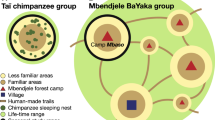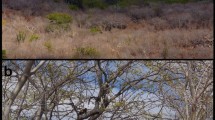Abstract
Primate field studies often estimate daily travel distance (DTD) in order to estimate energy expenditure and/or test foraging hypotheses. In group-living species, the center of mass (CM) method is traditionally used to measure DTD; a point is marked at the group’s perceived center of mass at a set time interval or upon each move, and the distance between consecutive points is measured and summed. However, for groups using multiple travel paths, the CM method potentially creates a central path that is shorter than the individual paths and/or traverses unused areas. These problems may compromise tests of foraging hypotheses, since distance and energy expenditure could be underestimated. To better understand the magnitude of these potential biases, I designed and tested the multiple travel paths (MTP) method, in which DTD was calculated by recording all travel paths taken by the group’s members, weighting each path’s distance based on its proportional use by the group, and summing the weighted distances. To compare the MTP and CM methods, DTD was calculated using both methods in three groups of Udzungwa red colobus monkeys (Procolobus gordonorum; group size 30–43) for a random sample of 30 days between May 2009 and March 2010. Compared to the CM method, the MTP method provided significantly longer estimates of DTD that were more representative of the actual distance traveled and the areas used by a group. The MTP method is more time-intensive and requires multiple observers compared to the CM method. However, it provides greater accuracy for testing ecological and foraging models.


Similar content being viewed by others
Abbreviations
- CM:
-
Center of mass
- DTD:
-
Daily travel distance
- MTP:
-
Multiple travel paths
References
Altmann J, Samuels A (1992) Cost of maternal care: infant-carrying in baboons. Behav Ecol Sociobiol 29:391–398
Clutton-Brock TH (1975) Ranging behaviour of red colobus (Colobus badius tephrosceles) in the Gombe National Park. Anim Behav 23:706–722
Doran D (1997) Influence of seasonality on activity patterns, feeding behavior, ranging, and grouping patterns in Taï chimpanzees. Int J Primatol 18:183–206
Ganskopp DC, Johnson DD (2007) GPS error in studies addresses animal movements and activities. Rangel Ecol Manag 60:350–358
Garmin (2010) Mapsource version 6.15.6, software. Garmin Ltd., Olathe
Isbell LA, Pruetz JD, Nzuma BM, Young TP (1999) Comparing measures of travel distances in primates: methodological considerations and socioecological implications. Am J Primatol 48:87–98
Pebsworth PA, Morgan HR, Huffman MA (2012) Evaluating home range techniques: use of Global Positioning System (GPS) collar data from chacma baboons. Primates 53(4):345–355
R Core Team (2012) R: a language and environment for statistical computing. R Foundation for Statistical Computing software, Vienna
Ren B, Li M, Long Y, Grüter CC, Wei F (2008) Measuring daily ranging distances of Rhinopithecus bieti via a Global Positioning System collar at Jinsichang, China: a methodological consideration. Int J Primatol 29(3):783–794
SAS Institute (2010) JMP®, version 9.0.0. SAS Institute, Inc., Cary, NC, 1989–2007
Sprague DS (2000) Topographic effects on spatial data at a Japanese macaque study site. Am J Primatol 52:143–147
StatSoftc (2001) Statistica version 6, software. Statsoft, Inc., Tulsa
Steel RI (2012) The effects of habitat parameters of the behavior, ecology, and conservation of the Udzungwa red colobus monkey (Procolobus gordonorum) PhD Thesis. Duke University
Struhsaker TT (2010) The red colobus monkeys: variation in demography, behavior, and ecology of endangered species. Oxford University Press, New York
Synergy Software (2003) KaleidaGraph version 3.6 software. Synergy Software, Reading
Acknowledgments
I thank Drs. Tom Struhsaker, Ken Glander, and Janine Chalk for constructive comments, Jack Mock, Aloyce Kisoma, and Titus Makweta for assistance in the field, and the Margot Marsh Biodiversity Foundation for partly funding this project. Research protocols were reviewed by and permission granted by the Institutional Animal Care and Use Committee (#A302-08-11), Tanzania Wildlife Research Institute, Tanzania Commission for Science and Technology (#2008-362-ER-2008-152), Tanzania National Parks, and the Tanzanian Immigration Department. Animal treatment complied with the ethical standards of the Institutional Animal Care and Use Committee.
Author information
Authors and Affiliations
Corresponding author
About this article
Cite this article
Steel, R.I. Using multiple travel paths to estimate daily travel distance in arboreal, group-living primates. Primates 56, 71–75 (2015). https://doi.org/10.1007/s10329-014-0449-8
Received:
Accepted:
Published:
Issue Date:
DOI: https://doi.org/10.1007/s10329-014-0449-8




